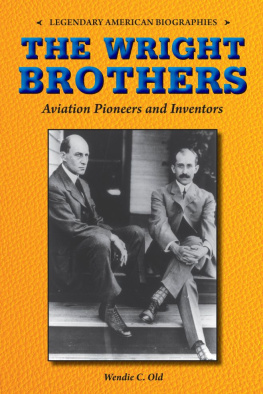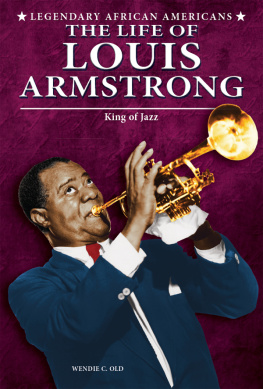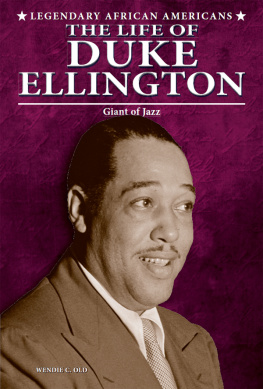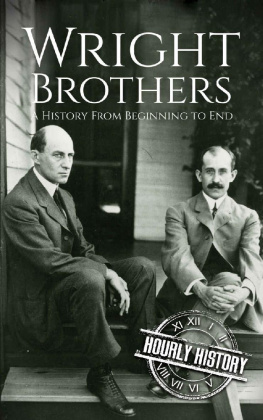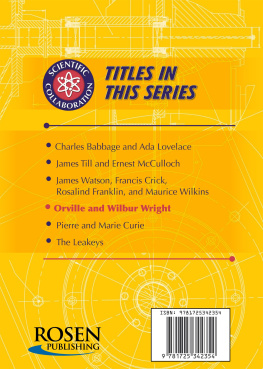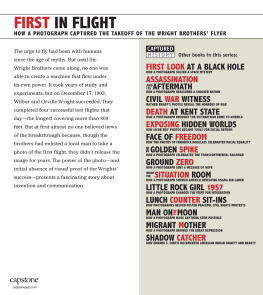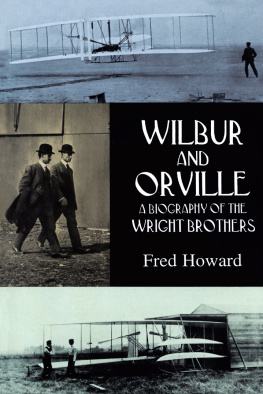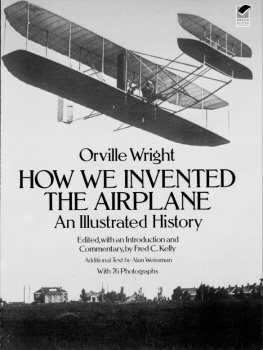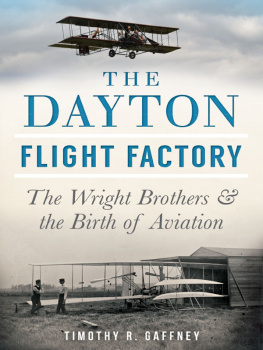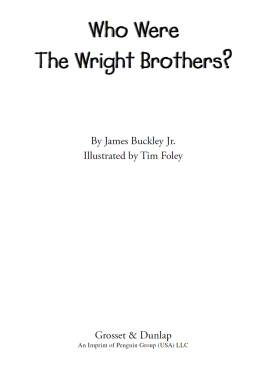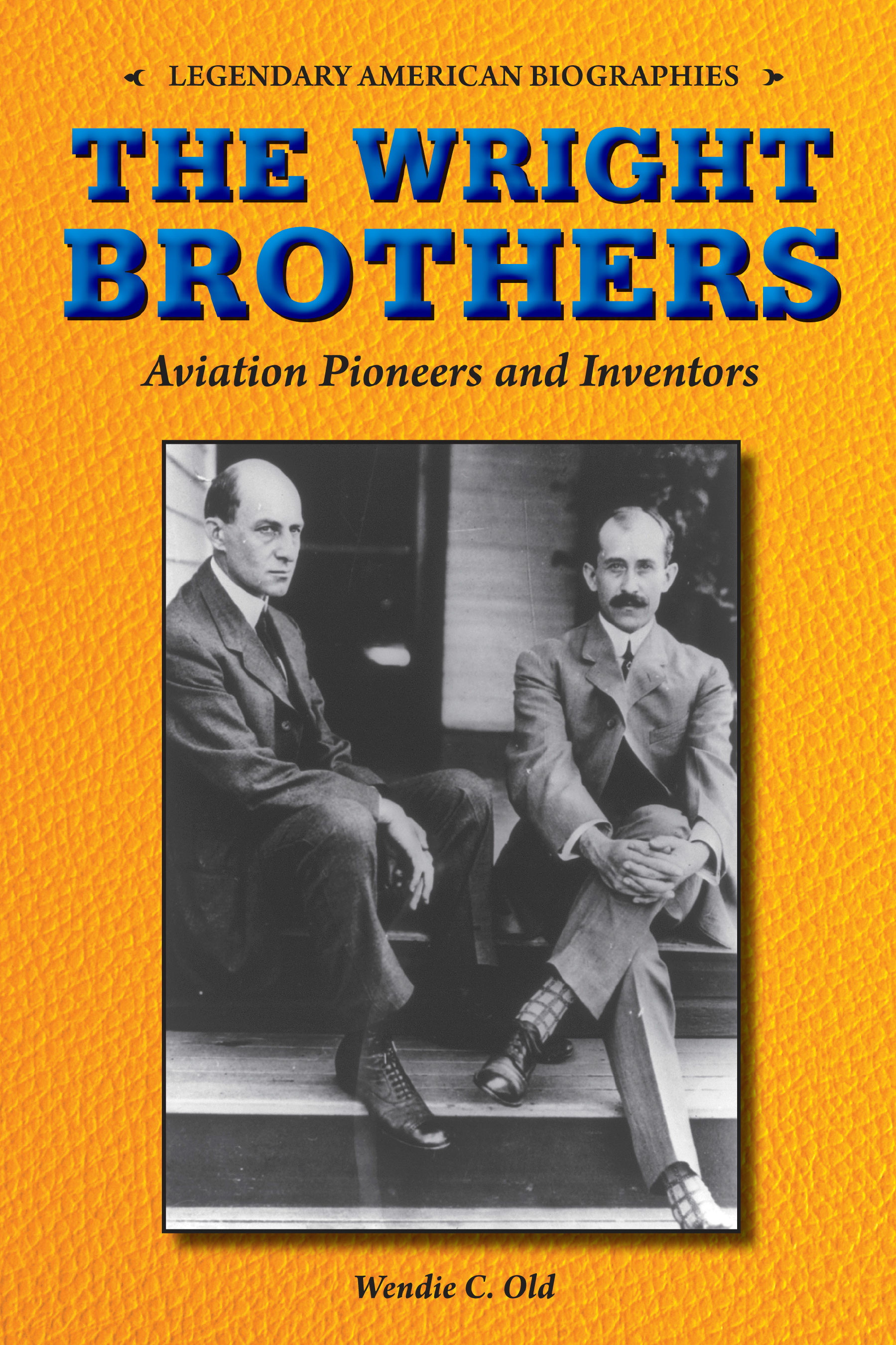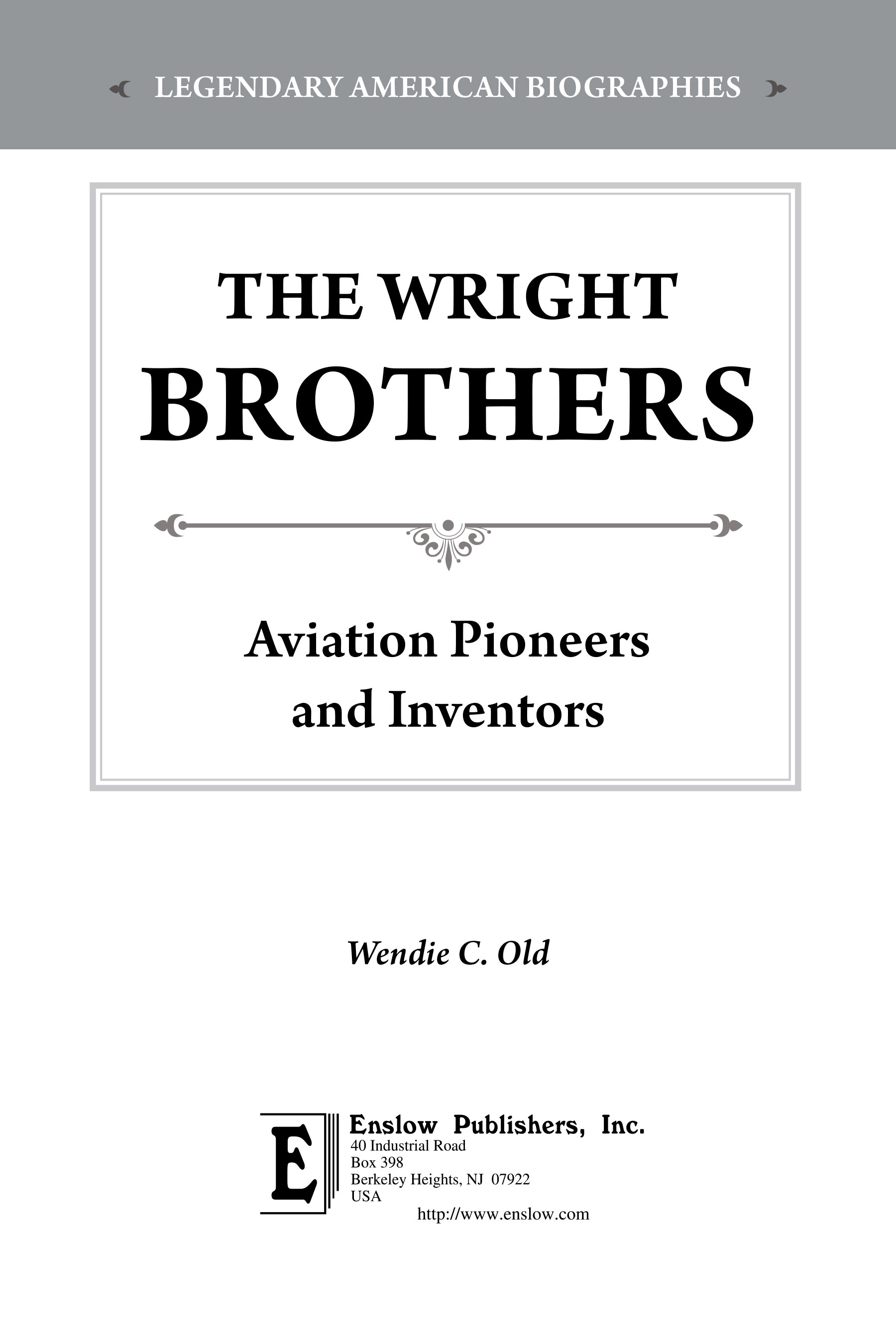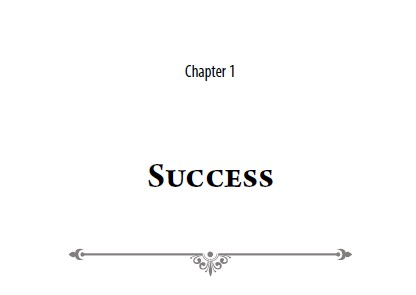Copyright 2015 by Wendie C. Old All rights reserved.
Originally published as The Wright Brothers: Inventors of the Airplane in 2000.
No part of this book may be reproduced by any means without the written permission of the publisher.
Library of Congress Cataloging-in-Publication Data
Old, Wendie C., author..
The Wright brothers : aviation pioneers and inventors / Wendie C. Old. pages cm. (Legendary American biographies)
Originally published as: The Wright Brothers: Inventors of the Airplane in 2000." Summary: Traces the path of the Wright Brothers as they pursued their dream of changing the world of aviation." Provided by publisher.
Audience: Grades 4 to 6.
Includes bibliographical references and index.
ISBN 978-0-7660-6505-5 (hardcover)
1. Wright, Orville, 1871-1948Juvenile literature. 2. Wright, Wilbur, 1867-1912Juvenile literature. 3. InventorsUnited StatesBiographyJuvenile literature. 4. AeronauticsUnited StatesBiography-Juvenile literature. I. Title. TL540.W7O43 2015 629.13'0092'2dc23
2014029271
Future Editions:
Paperback ISBN: 978-0-7660-6506-2 EPUB ISBN: 978-0-7660-6507-9 Single-User PDF ISBN: 978-0-7660-6508-6 Multi-User PDF ISBN: 978-0-7660-6509-3
This is the PDF version 1.0.
To Our Readers: We have done our best to make sure all Internet addresses in this book were active and appropriate when we went to press. However, the author and the publisher have no control over and assume no liability for the material available on those Internet sites or on other Web sites they may link to. Send comments to or to the address on the back cover.
w Enslow Publishers, Inc., is committed to printing our books on recycled paper. The paper in every book contains 10% to 30% post-consumer waste (PCW). The cover board on the outside of each book contains 100% PCW. Our goal is to do our part to help young people and the environment too!
Illustration Credits: Library of Congress, pp. 4, 6, 10, 20, 32, 37, 48; Shutterstock.com:
A-R-T (scrolls).
Cover Illustration: Library of Congress
Contents
Wilbur (left) and Orville Wright are still remembered for their amazing accomplishments and for starting the age of aviation.
S ince the early 1980s, 6 million license plates have told the world that North Carolina is First in Flight." Why? Because two bicycle builders from Dayton, Ohio, used the Outer Banks of North Carolina for their research about flight. They needed the barren sand dunes, the open spaces, and the constant seashore wind to test their experimental craft.
Wilbur and Orville Wright came yearly to the lonely windswept area from 1900 to 1903. There, they tested gliders at the large sand dunes, called Kill Devil Hills, four miles south of the small village of Kitty Hawk.
In the fall of 1903, their double-winged, motor-propelled contraptionnamed the Flyerwas ready to be tested with a man aboard. To lift their Flyer into the air, the Wright brothers calculated that they would need a lightweight motor that produced at least nine horsepower.
None of the newly invented automobile companies could supply a motor that exactly suited the needs of the Wright brothers. The brothers had to build their own motor out of cast aluminum and steel. They used aluminum because it is a strong as well as a lightweight metal.
According to their calculations, their motor would produce the needed nine horsepower. To their surprise, it actually generated twelve horsepowermore than enough to lift the Flyer into the air.
The Flyer was partially constructed in Dayton and weighed before shipping to Kitty Hawk, North Carolina. In the end, the Wrights calculated its weight to be 675 pounds. Although slightly heavier than the Wrights had wanted, they thought it still might lift off the ground with the stronger horsepower engine.

Rear view of the Wright brothersfour-cylinder motor as installed in their 1903 airplane. Orville and Wilbur designed the engine used in the first successful flight. Charlie Taylor built the engine under their direction.
On the Outer Banks
More storms hit the Outer Banks during the fall of 1903 than in previous years. Between the storms, the Wright brothers pieced together the Flyer in the wooden shed at their camp near Kill Devil Hills.
However, the first test of the engine on November 5 damaged the propeller shafts. These had to be sent to the mainland to be repaired. When they were reinstalled, the brothers spent a week adjusting them. On November 28, one of the propeller shafts cracked. Orville took it home to Dayton to be repaired.
While Wilbur waited for Orville to return, the weather became mild and clear. The next week was perfect flying weather. In fact, several hundred miles north, another aviator was preparing to prove that his airplane design would be the first to fly.
The Competition
Samuel Pierpont Langley, the head of the Smithsonian Institution in Washington, D.C., had experimented with flight for years. He was a trained scientist, and his work was supported by government money. He planned to launch his Great Aerodrome over water.
On Tuesday, December 8, tugboats pulled a large houseboat from a wharf at the foot ofEighth Street in southwest Washington, D.C. They plowed through patches of floating ice to the junction of the Potomac and Anacosta rivers.
Langley had run out of money. This was his last chance. He watched from shore with a small party of friends, including Alexander Graham Bell, inventor of the telephone, and some Smithsonian employees. The pilot, Charles Manly, stripped off his outer clothing. To cut down on weight, he would fly in his long underwear and a cork-lined life jacket.
At 4:45 P.M., the Great Aerodrome was thrown off the houseboat by a catapult. It slid along a track. When it reached the edge of the roof of the houseboat, instead of flying, Manly felt a sharp jerk. He did not see water below him. He saw sky. The Aerodrome had flipped over. Its wings were shaped wrong. They could not lift the Great Aerodrome into the sky. Instead, it splashed into the water.
Manly became tangled in the broken wood and wire under water. As he tried to surface, he encountered ice above his head. Finally, he reached open water and was pulled out of the freezing river.
Langleys twenty-year struggle to fly had failed. The newspapers made fun of him. Another foolish person had fought the law of gravity and had lost.
The Wrights' First Attempt
Meanwhile, Orville Wright returned to the Outer Banks with the repaired propeller shaft. On December 14, members of the nearby Kill Devil Hills Lifesaver Corps helped the Wrights drag the Flyer to the base of a nearby dune and lay a single rail. The brothers first attempt at flying would use a nine-degree slope down the dune to get a gravity-assisted start.

